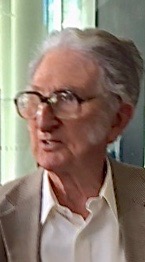Michael Halliday (1985) cited in: Xueyan Yang (2010) Modelling Text As Process. p. 20.
1970s and later
Michael Halliday: Frasi in inglese
Origine: 1970s and later, Explorations in the functions of language, 1973, p. 49 cited in: William O. Beeman (1986) Language, Status, and Power in Iran. p. 65.
“The theme is what is being talked about, the point of departure for the clause as message”
Origine: 1970s and later, Cohesion in English (English Language), 1976, p. 212.
Contesto: The theme is what is being talked about, the point of departure for the clause as message, and the speaker has within certain limits the option of selecting any element in the clause as thematic.
Michael Halliday in: G. Thompson (1998) " Interview with M. A. K. Halliday, Cardiff, July 1998 http://www.scielo.br/pdf/delta/v17n1/a06v17n1.pdf". Answer to the question, how he saw his own work as fitting into the development of linguistics.
1970s and later
Origine: 1970s and later, Cohesion in English (English Language), 1976, p. xix cited in: Sanna-Kaisa Tanskanen (2010) Discourses in Interaction. p. 118.
Origine: 1950s–1960s, The Linguistic Sciences and Language Teaching, 1964, p. 13. cited in: David Brazil (1995) A Grammar of Speech. p. 9.
Origine: 1970s and later, Explorations in the functions of language, 1973, p. 35 cited in: Terence Odlin (1994) Perspectives on Pedagogical Grammar. p. 193.
Origine: 1950s–1960s, The Linguistic Sciences and Language Teaching, 1964, p. 1.
“Foregrounding, as I understand it, is prominence that is motivated”
Origine: 1970s and later, Explorations in the functions of language, 1973, p. 112 cited in: Laura Hidalgo-Downing (2000) Negation, Text Worlds, and Discourse. p. 4.
Origine: 1970s and later, Learning How to Mean--Explorations in the Development of Language, 1975, p. 140 cited in: Clare Painter (2005) Learning Through Language In Early Childhood. p. 64.
Origine: 1970s and later, Explorations in the functions of language, 1973, p. xiv cited in: Piet Van de Craen (2007) Van Brussel gesproken. p. 118.
Origine: 1970s and later, Cohesion in English (English Language), 1976, p. 23 cited in: Helen Leckie-Tarry (1998) Language and Context. p. 6.
Michael Halliday (1985, p. xxiii) cited in: David Brazil (1995) A Grammar of Speech. p. 10.
1970s and later
Michael Halliday (2006, p. 68) as cited in: Andrew Halliday and Marion Glaser (2011).
1970s and later
Michael Halliday (2005, p. 68) as cited in: Andrew Halliday and Marion Glaser (2011) "A Management Perspective on Social Ecological Systems". In: Human Ecology Review, Vol. 18, No. 1, 2011.
1970s and later
Origine: 1970s and later, Learning How to Mean--Explorations in the Development of Language, 1975, p. 16 cited in Constant Leung, Brian V. Street (2012) English a Changing Medium for Education. p. 5.
Michael Halliday (1987) cited in: Margaret Laing, Keith Williamson (1994) Speaking in Our Tongues. p. 99.
1970s and later
Michael Halliday Notes on transitivity and theme in English: Part 2, 1967. p. 200 cited in: Klaus von Heusinger "Information Structure and the Partition of Sentence Meaning". In: Eva Hajičová (2002) Form, Meaning and Function. p. 287
1950s–1960s
Origine: 1970s and later, Learning How to Mean--Explorations in the Development of Language, 1975, p. 122 cited in: M.A.K. Halliday, Jonathan Webster (2006) The Language of Early Childhood. p. 289.
Origine: 1970s and later, Cohesion in English (English Language), 1976, p. 22 cited in: Helen Leckie-Tarry (1998) Language and Context. p. 6.
Michael Halliday (1978, p. 121) as cited in: Harry Daniels, Michael Cole, James V. Wertsch (2007) The Cambridge Companion to Vygotsky. p. 148.
1970s and later
Origine: 1970s and later, Explorations in the functions of language, 1973, p. 41 cited in: Sin-wai Chan (2004) A dictionary of translation technology. p. 113.
Michael Halliday (1977). "Ideas about Language" Reprinted in Volume 3 of MAK Halliday's Collected Works. Edited by J.J. Webster. London: Continuum. p113.
1970s and later
